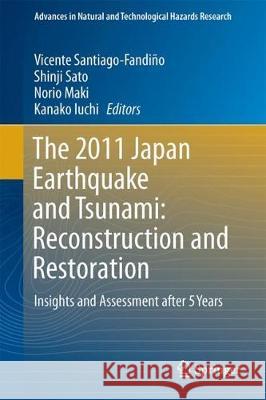The 2011 Japan Earthquake and Tsunami: Reconstruction and Restoration: Insights and Assessment After 5 Years » książka



The 2011 Japan Earthquake and Tsunami: Reconstruction and Restoration: Insights and Assessment After 5 Years
ISBN-13: 9783319586908 / Angielski / Twarda / 2017 / 485 str.
The 2011 Japan Earthquake and Tsunami: Reconstruction and Restoration: Insights and Assessment After 5 Years
ISBN-13: 9783319586908 / Angielski / Twarda / 2017 / 485 str.
(netto: 691,70 VAT: 5%)
Najniższa cena z 30 dni: 693,97 zł
ok. 22 dni roboczych
Bez gwarancji dostawy przed świętami
Darmowa dostawa!
Part I. Planning, Policy and Governance
<
Vicente Santiago worked in the United Nations Environment Programme (UNEP) for over 23 years. Initially as Deputy Coordinator of the Environmental Training Network for Latin America and the Caribbean (Mexico), then as Deputy Coordinator of the Regional Programme on Integrated Planning and Institutional Development for the Wider Caribbean Region (Jamaica), and finally as Water Officer at the International Environmental Technology Centre located in Japan. He has carried out projects and activities in various countries in the Caribbean region, Middle East, Africa, Asia and North and South America, as well as in Europe collaborating with governments, institutions and NGOs. His areas of expertise include integrated coastal zone management, integrated river and lakes management, water quality and wetlands, and lately natural hazards in coastal areas mainly earthquakes and tsunamis. He has published a number of technical reports, environmental training materials, scientific and technical papers as well as edited a number of books. He received his Bachelor degree as a Biologist at the National University of Mexico (UNAM), Master in Science degree in Marine Biology at the University College North Wales; Bangor (Wales, UK), and Ph.D. in Environmental Chemial Engineering (Applied Sciences) at Exeter University (England, UK) initiating his professional career as lecturer at the Metropolitan University of Mexico (UAM). At present he is an Invited Researcher at the International Lake Environment Committee Foundation (ILEC) in Japan and also works as a freelance consultant.
This book covers the restoration and reconstruction process and activities undertaken in Japan in the first five years since the 2011 Earthquake and Tsunami – a period widely considered to be the most intensive reconstruction phase within the 10-year restoration plan drawn up by the Japanese Government.
The respective chapters explore technical, scientific, social and non-scientific (policy-related) aspects, including: reconstruction and restoration policies, infrastructure and designs for tsunami coastal defence, resilient urban areas and affected communities, housing and relocation schemes, disaster mitigation and evacuation measures, reactivation of the economy, revitalization of fisheries and coastal agriculture, and industry and tourism. The book also illustrates some of the achievements and failures in a broad range of projects and initiatives intended to address the above-mentioned issues, making it particularly relevant for experts, decision makers, students and other interested scholars.
1997-2025 DolnySlask.com Agencja Internetowa
KrainaKsiazek.PL - Księgarnia Internetowa









